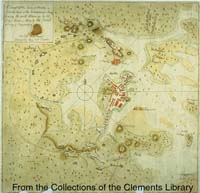The Mad Scientist
May 6, 1775 -- Benjamin Thompson
to Gage's Staff
 Benjamin
Thompson, one of the earliest and most famous American scientists, did
not believe in the American rebellion. In this letter, Thompson did
not hide his leanings towards the loyalist cause, but he did use invisible
ink to include secret text within the body of his letter. The
secret letter is proof of Thompson's previously suspected intelligence
work for the British Army. Thompson wrote this letter from Woburn,
Massachusetts because he had been run out of his hometown in New Hampshire
for sending British deserters back to Gage's headquarters in Boston.
In the beginning of the letter, Thompson briefly mentioned the Battle of
Lexington and Concord that had happened two weeks prior, stating that Gage
has "already better intelligence of them affairs than I am able to give."
Instead he concentrated on explaining the movements of the "Rebel Army
(if that mass of confusion may be called an Army)."
Benjamin
Thompson, one of the earliest and most famous American scientists, did
not believe in the American rebellion. In this letter, Thompson did
not hide his leanings towards the loyalist cause, but he did use invisible
ink to include secret text within the body of his letter. The
secret letter is proof of Thompson's previously suspected intelligence
work for the British Army. Thompson wrote this letter from Woburn,
Massachusetts because he had been run out of his hometown in New Hampshire
for sending British deserters back to Gage's headquarters in Boston.
In the beginning of the letter, Thompson briefly mentioned the Battle of
Lexington and Concord that had happened two weeks prior, stating that Gage
has "already better intelligence of them affairs than I am able to give."
Instead he concentrated on explaining the movements of the "Rebel Army
(if that mass of confusion may be called an Army)."
Within the visible text of the letter, Thompson
reported on the actions of the Continental Congress' resolution to
raise 30,000 men against the British which he had learned from a member
of the Provincial Congress of Massachusetts, possibly Benjamin Church.
He also detailed the Rebel Army's plan to attack the "Castle,"
or the Castle William Fort at Castle Rock. Instead the Continental
Army, led by Ethan Allen and Benedict Arnold, attacked Fort Ticonderoga
in Lake Champlain. In invisible ink Thompson wrote of a secret cache
of papers, unfortunately the name of the courier has been erased and nothing
is known of the Thompson's papers. In October 1775, around the same
time Benjamin
Church was tried for treason by Washington, Thompson left Boston and
returned home to New Hampshire to his wife for a short time. On November
4, 1775, Thompson was back in Boston writing a detailed report on the conditions
in the American camp for Sir
William Howe, General Gage's replacement. In March of 1776, when
Howe evacuated Boston, Thompson sailed to England to assist Lord
George Germain who ran the British troops from England. Thompson
failed to notify his wife and small daughter in Concord, New Hampshire
of his plans and they never saw him again.
Previous Story |
Next Story |
![]()
|
|
|
|
Letters | Stories | Methods | People | Routes | Timeline | Home
Clements Library | Sir Henry Clinton Collection | Teachers' Lounge | About the Project | Bibliography